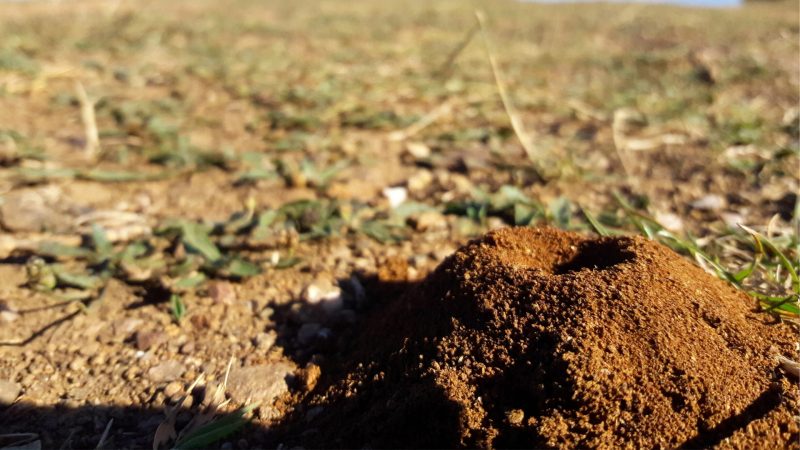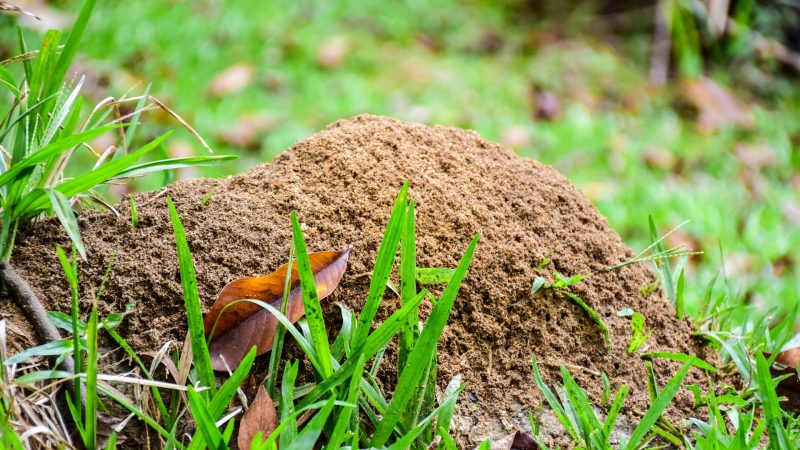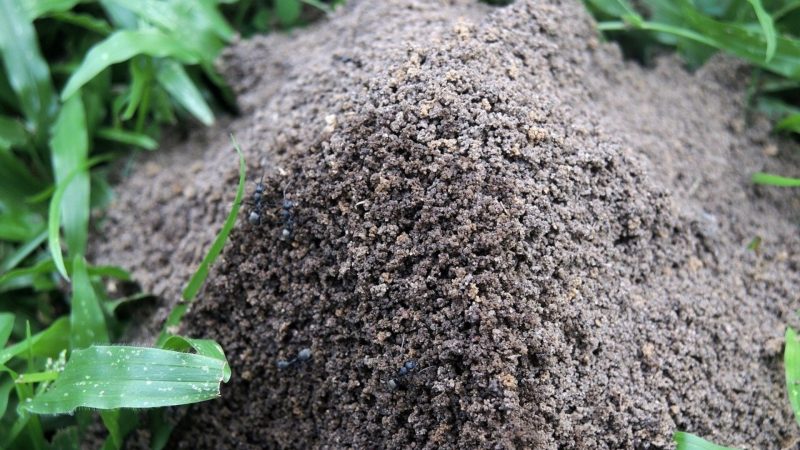Ant hills can be a real pain for us who love keeping our yard and garden picture-perfect. These insects play an essential role in our ecosystem. But considering their mounds are a real eyesore, I prefer them to keep that elsewhere!
To get rid of ant hills, pour boiling water over the ant hill. However, this method will not eliminate the queen. Alternatively, you can apply boric acid over the entry points of the ant hills. For a more effective long-term solution, place ant baits (granules) around your yard, particularly along pheromone trails where the ants are likely to find them.
Depending on the size of the ant hill, you might need different solutions and products to suit your needs. Before we dive into the step-by-step process of getting rid of ant hills, let’s take a moment to discuss what ant hills are and why ants build them. By understanding these fascinating creatures and their habits, you’ll be better equipped to eradicate them from your yard.
What Are Ant Hills?
Ant hills are mounds of dirt found in various sizes almost anywhere. They are typically composed of soil, rocks, sand, and other materials and can be either soft or hard in texture. While ant hills indicate the location of the ants’ residence, most of the colony is underground.
How Do Ants Build an Ant Hill?
Although building an ant hill may seem random, it serves several strategic purposes for the colony, including regulating internal temperature, acting as an entry point, and protecting the colony from predators. The ant hill provides a stable environment for the colony, which the ants regulate to maintain a constant temperature.
How Deep Are Ant Hills?
Ant hills can be quite deep, ranging from 6 cm to 4 m (2.3622 inches to 13 feet) or more, depending on how long they have been there and the type of ant that resides within them.

Why Do Ants Make Ant Hills?
In sizable networks of tunnels and rooms, the majority of ant species occupy the underground. Like human miners, the workers carry the earth out and dump it at the entrance as they carve new passages and chambers. The end effect is ant hills.
What Is Inside an Ant Hill?
Ant hills are essentially just mounds of dirt or sawdust. However, many ant species have evolved much more intricate building strategies.
Sand, leaves, pine needles, gravel, small stones, and even tree resin can be found in ant mounds. Some unusual species even combine mud, sand, and tiny sticks to create different types of entrances.
Are Ant Hills Bad?
Ant hills are generally harmless, but they can be a nuisance and disfigure your yard. In the case of large colonies, they can even kill the plants around them.
Ants build their hills to be structurally sound and reinforce them to withstand heavy rain. Ants typically do not attack humans unless provoked, so you are safe from stings or bites as long as you don’t disturb them.
What Type of Ants Make Ant Hills?
Numerous ant species build ant hills, including Texas leafcutter ants, Allegheny mound ants, Pyramid ants, Harvester ants, Argentine ants, and Fire ants. Fire ant mounds are typically made of soft earth, but they will sting when provoked, so it’s important to avoid disturbing them during treatment.
Related: How Many Types of Ants Are There: Ant Identification Chart
World’s Biggest Ant Hills | Information and Facts
Due to their organized nature, rapid reproduction, and elaborate mounds, ants have the potential to become a problem when left unchecked. While some ant nests can be easily managed due to their small size, others have become famous for their massive scale, earning a place in the Guinness Book of World Records.
In the year 2000, a supercolony of Argentine ants was discovered in Southern Europe, stretching over 3,700 miles with billions of ant workers and millions of nests. This discovery surpassed the previous record holder, the Japanese super ant colony, by a significant margin. The Hokkaido ant colony, which held the title previously, had 45,000 nests that stretched over 670 acres of land.
Why Are There So Many Ant Hills in My Yard?
Anthills may start to appear in your yard due to the availability of the supplies they need to survive and proliferate. If these things are regularly accessible in your yard, you might see the appearance of ant hills there.
- Water
- Food sources
- Preferred soil conditions
Ants like to establish their colonies near readily available resources, such as food and water. Fountains and dripping pipes are frequent reliable water sources.
Ants prefer to settle in soil that has favorable building conditions. These ideal circumstances include sandy soil that is somewhat loose, dry, and draining and receives hours of direct sunlight each day.
Difficulty in Destroying Ant Hills
If you’ve ever tried to remove an ant hill, you’ve probably felt the annoyance of witnessing it reappear in the same place or another close area. Certain factors can make eliminating ant mounds extremely difficult:
- The queen must perish in order to completely destroy an ant colony, but she is challenging to locate.
- Effective remedies may vary depending on the species of ant involved in ant hills. As a result, homeowners may find it challenging to try DIY techniques for eliminating ant hills.
- Ant treatment is complicated because different species of ants have distinct preferences for food and environment. Because of this, it’s better to leave ant control to a pro who can recognize the kind of ants you have and advise you on how to get rid of them.
Get Rid of Ant Hills Naturally

The following home remedies can also be used to eliminate ant hills, but they are generally less effective than the products and methods we have recommended.
- Borax and Sugar Bait: A mixture of borax and sugar, honey, or peanut butter can be used as an ant bait. Ensure that you have placed enough baits around the compound for maximum effectiveness.
- Diatomaceous Earth: Diatomaceous earth can be used to kill ants. Sprinkle the dust over the ant hill to dehydrate and kill the ants.
- Vinegar: Using vinegar to eliminate ant hills is less effective than other methods. You can mix it with water and flood the ant tunnels to drown some ants, but the results may not be very good.
- Boric Acid: Boric acid is very effective. You can sprinkle it over the ant hill or on the ant trails to kill the ants.
- Mechanical Removal: If you prefer not to use chemical methods, you can manually remove the ant hills. Flood the tunnels with hot soapy water to kill any remaining ants. After that is done, level the ground and plant on it, ensuring that all entry points are well sealed to avoid any other ant colony.
- Boiling Water Method: In boiling water, ants can’t survive for very long. Three or more liters of boiling water are required to completely eradicate an ant colony.
Best Ant Hill Killer Products
Sale 1
TERRO T600 Ant Dust Powder Killer for Indoors and Outdoors - Kills Ants, Fire Ants, Carpenter Ants, Roaches, Spiders, and Other Insects , 1lb
- Effectively Kills Insects - Kills ants (including fire &...
- Waterproof Formula - The waterproof dust won't wash in the rain
- Fast Acting & Long Lasting - This dust kills insects on contact...
- Easy to Apply - The convenient shaker canister allows for both...
- Use Indoors & Outdoors - Apply in cracks and crevices, around...
Sale 2
Ortho Orthene Fire Ant Killer1, Kills the Queen, Destroys up to 162 Mounds, Begins Working in 60 minutes, 12 oz.
- Ortho Orthene Fire Ant Killer1 kills the queen, destroys the...
- This fire ant killer begins killing in just 60 minutes so you can...
- Kill fire ants outdoors on your lawn and around ornamental...
- To treat fire ant mounds, simply sprinkle the product over each...
- Use as part of the Ortho 2-Step System with Ortho Fire Ant Killer...
3
Mighty Mint Peppermint Oil Ant Killer Spray – Natural Ant Repellent for Indoor & Outdoor Use – Plant-Based Insect & Pest Control – 16 oz
- PET-FRIENDLY & FAMILY-SAFE FORMULA – Mighty Mint is a top pick...
- POWERFUL PLANT-BASED PEST CONTROL – Formulated with...
- EFFECTIVE INDOOR & OUTDOOR USE – Designed for treating ant...
- FRESH MINTY SCENT WITH LONG-LASTING EFFECT – Infused with pure...
- READY-TO-USE 16 OZ SPRAY FOR TARGETED APPLICATION – Perfect for...
4
Spectracide Fire Ant Shield Mound Destroyer Granules, Destroys Fire Ant Mound, Kills Queen and Colony, 7 lb
- Item Package Dimension: 16.4199999832516L x 12.1699999875866W x...
- Item Package Weight - 7.16943276024 Pounds
- Item Package Quantity - 1
- Product Type - PESTICIDE
- Effectively Kills Insects - Kills ants (including fire &...
- Waterproof Formula - The waterproof dust won't wash in the rain
- Fast Acting & Long Lasting - This dust kills insects on contact...
- Easy to Apply - The convenient shaker canister allows for both...
- Use Indoors & Outdoors - Apply in cracks and crevices, around...
- Ortho Orthene Fire Ant Killer1 kills the queen, destroys the...
- This fire ant killer begins killing in just 60 minutes so you can...
- Kill fire ants outdoors on your lawn and around ornamental...
- To treat fire ant mounds, simply sprinkle the product over each...
- Use as part of the Ortho 2-Step System with Ortho Fire Ant Killer...
- PET-FRIENDLY & FAMILY-SAFE FORMULA – Mighty Mint is a top pick...
- POWERFUL PLANT-BASED PEST CONTROL – Formulated with...
- EFFECTIVE INDOOR & OUTDOOR USE – Designed for treating ant...
- FRESH MINTY SCENT WITH LONG-LASTING EFFECT – Infused with pure...
- READY-TO-USE 16 OZ SPRAY FOR TARGETED APPLICATION – Perfect for...
- Item Package Dimension: 16.4199999832516L x 12.1699999875866W x...
- Item Package Weight - 7.16943276024 Pounds
- Item Package Quantity - 1
- Product Type - PESTICIDE
How to Get Rid of Ant Hills?
Yard
To eliminate ant hills in your backyard, you’ll need a long-lasting pesticide. Most pesticides offer three to six months of effectiveness, after which you’ll need to treat the yard again. For large ant hills, follow the instructions in the next section.
Liquid insecticides can harm the environment, so we generally don’t recommend them except for use by professional ant exterminators. Instead, applying a granulated or powdered pesticide is a highly effective, long-lasting solution. You should apply the product generously to ensure the pesticide reaches all the ants, including the queen. Some pesticides require activation with water.
Note: Some of these products will be discussed in more detail below. Whatever product you choose, read the instructions carefully for the best results.
How to Get Rid of Large Ant Hills?

You can eliminate large ant hills by following specific steps and using the right tools.
Step 1: Mow Down the Grass
First, mow down the grass around the large ant hill, cutting it as low as possible.
Step 2: Apply Insecticide
Apply one of our recommended products, such as Amdro Ant Block Granules, around the ant hill in the areas where the grass has been cut. Create a barrier around the ant hill and apply as much of the product as possible directly to the hill. Allow the bait to work for several days or weeks, depending on the size of the ant hill, to ensure it reaches the queen and destroys the colony.
Step 3: Flatten the Ant Hill
This process may take some time, depending on the size of the ant hill. To speed it up, mix one of our recommended products with the soil, and sprinkle it around the yard to prevent ants from dispersing.
If you encounter the queen, eliminate her to ensure the colony is destroyed. Remember that this method may not be as effective as waiting for the bait to kill the queen, so it’s best to use both approaches for maximum effectiveness.
Pouring Aluminum into Ant Hill: Is This a Good Way to Get Rid of Them?
Aluminum casting is an interesting method that requires caution and preparation. It can produce unique and artistic results. If you’re interested in trying it to get rid of an ant hill, here’s what you’ll need:
- Aluminum sources, such as soda cans or scavenged aluminum objects
- Forge, hearth, or fireplace for heating the metal
- Melting pot for the aluminum items
- Fire extinguisher
- Welding gloves and apron
- Face shield
- Tongs
- Sand
Once you have your equipment, you can begin the process. Heat the aluminum in the melting pot on the forge until it is liquid, making sure to take precautions to protect yourself. Then, shape sand around the ant hill’s opening as a barrier to keep the molten aluminum from flowing away from the mound as you pour.
To prevent mishaps, keep a fire extinguisher nearby if the aluminum flows away from the opening. Also, ensure the sand doesn’t block the hole or keep the molten aluminum from flowing through the tunnels.
Pour the aluminum into the ant hill’s opening until the aluminum stops flowing inside the tunnels and fills up the sand opening. Melt more aluminum than you need to account for the depth of the ant tunnels. After a couple of hours, when the aluminum is solid, carefully dig around the top of the cast. Be sure not to burn yourself if the casting is still hot or even break it off.
Once you have removed the cast, hose it down to remove any dirt trapped between the casting branches. Depending on how well you followed the above instructions or even how deep the tunnels were, you should have a beautiful piece of art that you can display in your home or do as you, please.
List of Sources
Lewis D., Ant Mounds in Lawns, Iowa State University
Ant mounds in lawns and sidewalks, Iowa State University
Maier R.M., Potter D.A., Factors affecting distribution of the mound-building ant Lasius neoniger (Hymenoptera: Formicidae) and implications for management on golf course putting greens. J Econ Entomol
Mound ants, Michigan State University Extension
Bristow C. M., Cappaert D., Campbell N. J., Heise A., (1992), Nest structure and colony cycle of the Allegheny mound ant
- How to Get Rid of Copperheads | Practical Guide - August 27, 2023
- How to Get Rid of Corn Snakes | What Makes Them Aggressive? - August 27, 2023
- How to Get Rid of Alligators | Safety Measures and Removal Methods - July 16, 2023




